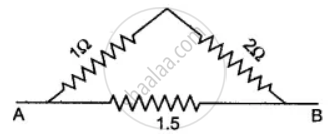Advertisements
Advertisements
प्रश्न
State whether the following statement is True or False:
The SI unit of charge is the coulomb.
पर्याय
True
False
उत्तर
True.
APPEARS IN
संबंधित प्रश्न
What does an electric circuit mean?
Which of the following equation shows the correct relationship between electrical unit?
1A = 1C/s or 1c= 1A/s
Compare how an ammeter and a voltmeter are connected in a circuit.
Ten bulbs are connected in a series circuit to a power supply line. Ten identical bulbs are connected in a parallel circuit to an identical power supply line.
(d) Which circuit would have less current in it?
Two lamps, one rated 40 W at 220 V and the other 60 W at 220 V, are connected in parallel to the electric supply at 220 V.
(a) Draw a circuit diagram to show the connections.
(b) Calculate the current drawn from the electric supply.
(c) Calculate the total energy consumed by the two lamps together when they operate for one hour.
State three factors on which the heat produced by an electric current depends. How does it depend on these factors?
Calculate the effective resistance between the points A and B in the network shown below in Figure 8.45

A wire of length 5 m has a resistance of 2.0 Ω calculate:
(a) the resistance of wire of length 1 m
(b) the equivalent resistance if two such wires each of length 2 m are joined in parallel.
(c) the resistance of 1 m length of wire of same material but of half diameter.
The following circuit diagram shows three resistors 2 Ω, 4 Ω and R Ω connected to a battery of e.m.f 2V and internal resistance 3 Ω. If the main current of 0.25 A flows through the circuit, find:
- the p.d. across the 4 Ω resistors,
- the p.d. across the internal resistance of the cell,
- the p.d. across the R Ω or 2 Ω resistors, and
- the value of R.

State the relation between work, charge and potential difference for an electric circuit.
The following table shows the current in Amperes and potential differences in Volts.
- Find the average resistance.
- What will be the nature of the graph between the current and potential difference? (Do not draw a graph.)
- Which law will the graph prove? Explain the law.
| V (volts) | I (amp) |
| 4 | 9 |
| 5 | 11.25 |
| 6 | 13.5 |
Match the pairs.
| ‘A’ Group | ‘B’ Group |
| 1. Free electrons | a. V/R |
| 2. Current | b. Increases the resistance in the circuit |
| 3. Resistivity | c. Weakly attached |
| 4. Resistances in series | d. VA/LI |
State the S.I. units of electrical power.
Complete the following:
1 kWh = _________ J
What should I choose ___________________
b. for getting protection from electric current.
c. to measure the current in the circuit?
Answer the following question.
What is the function of a galvanometer in a circuit?
Unit of electric power may also be expressed as
